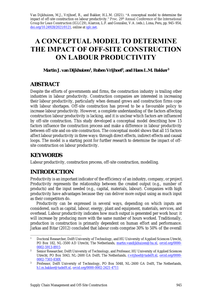The lack of in-depth understanding of the seismic behavior and ductility of precast concrete structures makes it difficult to reach to ductility demand which could be exhibited during an earthquake. The limitations are mainly related to the beam-to-column connections as the main load transfer paths. Two distinct exterior beam-column connections made of normal-strength concrete are investigated experimentally. Both dry and wet type installment techniques are used in the industrial type joints while the residential type joints are wet connections. The specimens are subjected cyclic displacement reversals in order to obtain information on strength, stiffness and ductility characteristics of the connection details. The preliminary design of the joints has been updated during the tests based on the damages observed, thus a set of improved specimens have also been built and tested, and a relatively better performance is obtained expectedly. The industrial and residential types of connections showed stable load-displacement cycles with high energy dissipation up to structural drift of 2%, though a significant level of pinching and deterioration of the critical section have occurred at around 3% drift level. The tested specimens have been numerically modeled to calibrate the analytical tools, and a satisfactory approximation has been obtained between experimental and numerical results.
LINK
Despite the efforts of governments and firms, the construction industry is trailing other industries in labour productivity. Construction companies are interested in increasing their labour productivity, particularly when demand grows and construction firms cope with labour shortages. Off-site construction has proved to be a favourable policy to increase labour productivity. However, a complete understanding of the factors affecting construction labour productivity is lacking, and it is unclear which factors are influenced by off-site construction. This study developed a conceptual model describing how 15 factors influence the construction process and make a difference in labour productivity between off-site and on-site construction. The conceptual model shows that all 15 factors affect labour productivity in three ways: through direct effects, indirect effects and causal loops. The model is a starting point for further research to determine the impact of off-site construction on labour productivity.
MULTIFILE

In recent years, the number of publications on innovation in the construction industry has increased. Many of these documents address qualitative issues, e.g. policies for innovation and present case studies. A more quantitative approach is taken in this paper, which is the continuation of a previous study. It focuses on main types and sources of innovation in the construction industry, and includes an analysis of 55 years of publications in two leading Dutch professional journals. The results show a recent increase in innovation, with two-thirds of innovations coming out of supplying industries. Construction companies contribute mainly in process innovations. Innovation in construction remains to be technology- rather than market-driven. Regulations have a surprising impact, as over one-third of all counted new innovations are related to new regulations.
DOCUMENT
